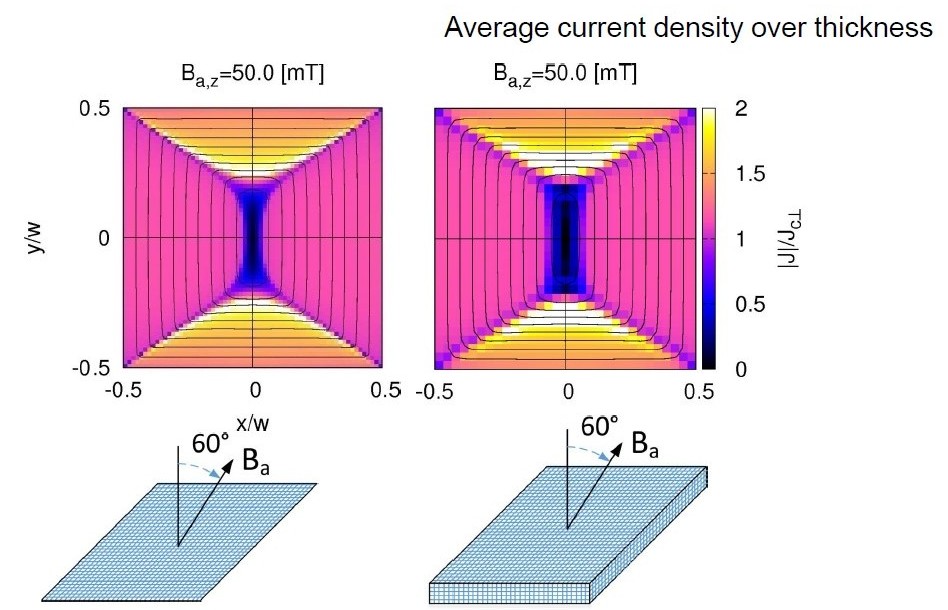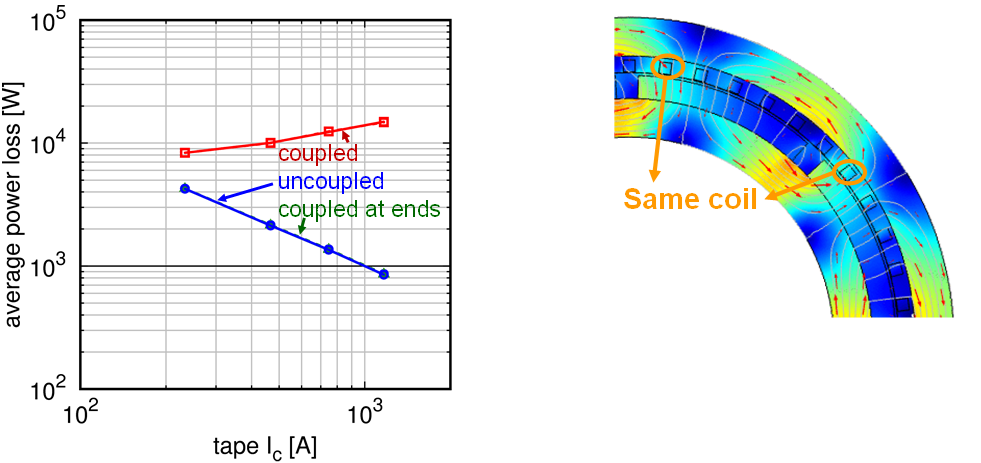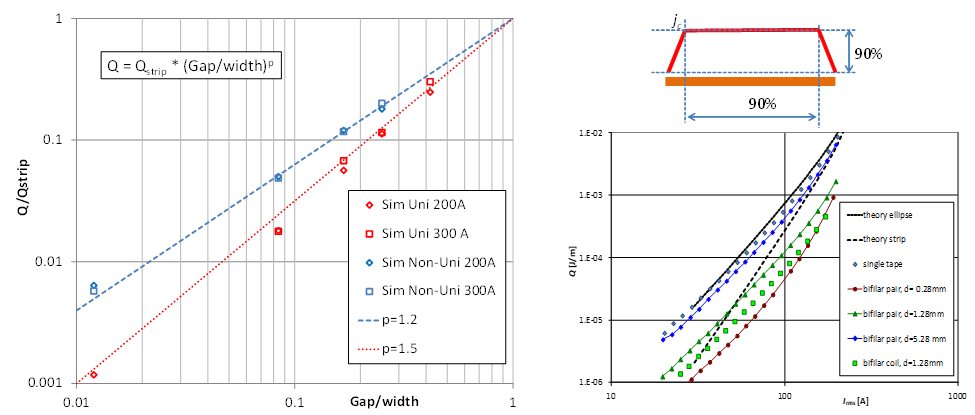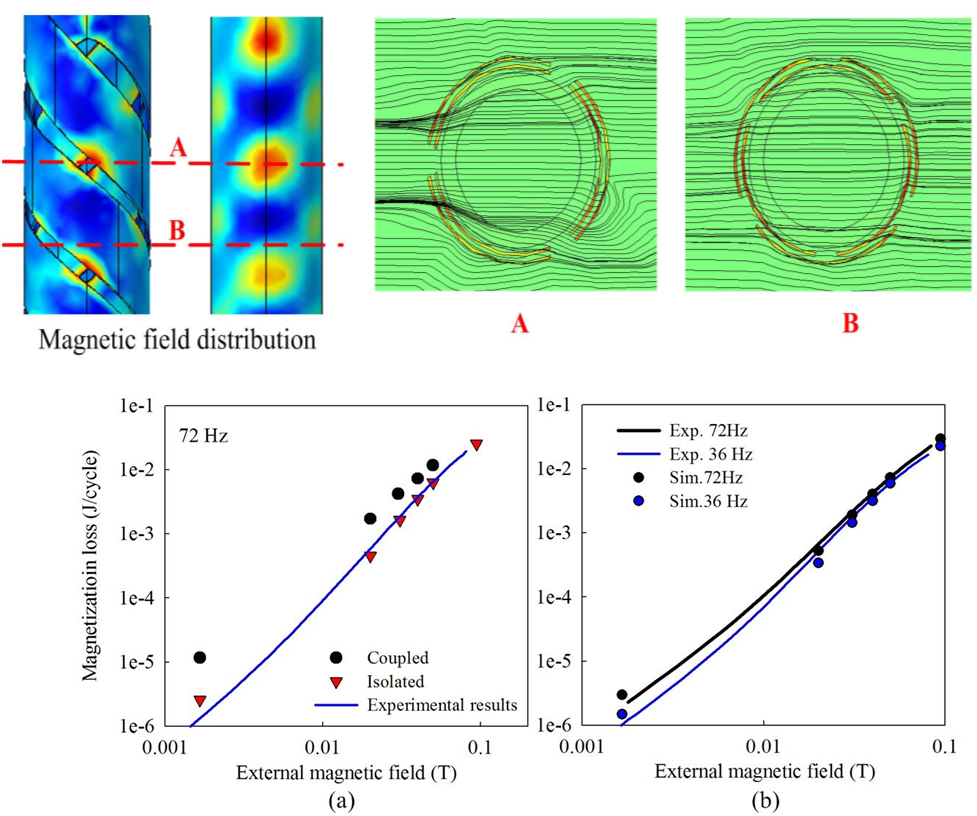In the department we study the transport of alternating electric current in single superconducting conductors (wires) and in the devices built out of them (cables, electromagnets, transformers,…). In contrast to the direct current transfer, electromagnetic energy losses arise in the alternating (AC) regime as a consequence of the magnetic flux pinning in the superconducting material.
It is important to explore different aspects of these so-called AC losses, in order to be able to predict their magnitude and to propose ways for their reduction. In our research, we combine theoretical calculations, including the development of new numerical methods, with experiments utilizing unique methods and techniques developed in our department. Thanks to involvement in international projects we cooperate with the international high-tech companies in resolving the most critical challenges regarding the utilization of superconductors.

Comparison of the electric current distribution in a thin film (left) and in a strip (right) from a superconductor with strong magnetic flux pinning, exposed to an AC magnetic field in an ‘inclined’ orientation. The result has been obtained employing a new numerical method based on minimisation of the magnetic entropy production.

Dependence of the AC losses in the winding of an airborne electric motor, calculated for three possible interconnections between the superconducting wires (left) based on the time-and-space distribution of magnetic fields obtained from numerical modelling (right).

Empirical rule enabling to predict the AC losses in the winding of a Fault Current Limiter (left), bifilarly wound from a high temperature superconducting tape with transport properties degraded at the edges (top right). The prediction, obtained through numerical modelling, has been confirmed by the experiments (bottom right).

Calculations of the AC losses in a single- and two-layer cable from a high temperature superconducting tape, compared with experiments (graphs in the bottom part). Illustration of the magnetic field distribution, obtained with the help of numerical modelling, is in the top part of the figure.
Selected publications:
Pardo, E., Grilli, F., Liu, Y., Wolftädler, S., and Reis, T.: AC loss modeling in superconducting coils and motors with parallel tapes as conductor, IEEE Trans. Applied Supercond. 29 (2019) 5202505.
Kapolka, M. and Pardo, E.: 3D modelling of macroscopic force-free effects in superconducting thin films and rectangular prisms, Supercond. Sci Technol. 32 (2019) 054001.
Gömöry, F. and Šouc, J.: AC losses in superconducting fault current limiters. In Superconducting fault current limiters: Innovation for the Electric Grids. Ed. P. Tixador. World Sci Publ. 2019. ISBN 978-981-3272-97-2 P. 45-60.
Terzioglu, R., Vojenčiak, M., Sheng, J., Gömöry, F., Çavuş, T., and Belenli, I.: AC loss characteristics of CORC® cable with a Cu former, Supercond. Sci Technol. 30 (2017) 085012.
Gömöry, F. and Sheng, J.: Two methods of AC loss calculation in numerical modelling of superconducting coils, Supercond. Sci Technol. 30 (2017) 064005.
Pardo, E. and Kapolka, M.: 3D magnetization currents, magnetization loop, and saturation field in superconducting rectangular prisms, Supercond. Sci Technol. 30 (2017) 064007.
Amaro, N., Šouc, J., Pardo, E., Murta-Pina, J., Martins, J., Ceballos, J., and Gömöry, F.: AC losses in Bi-2223 single-pancake coils from 72 to 1152 Hz – modeling and measurements, IEEE Trans. Applied Supercond. 26 (2016) 8202207.
Vojenčiak, M., Kario, A., Ringsdorf, B., Nast, R., van der Laan, D., Scheiter, J., Jung, A., Runtsch, B.,Gömöry, F., and Goldacker, W.: Magnetization ac loss reduction in HTS CORC® cables made of striated coated conductors, Supercond. Sci Technol. 28 (2015) 104006.
Pardo, E., Staines, M., Jiang, Z., and Glasson, N.: Ac loss modelling and measurement of superconducting transformers with coated-conductor Roebel-cable in low-voltage winding, Supercond. Sci Technol. 28 (2015) 114008.
Gömöry, F., Šouc, J., Vojenčiak, M., and Soloviov, M.: Round conductor with low AC loss made from high-temperature superconducting tapes, IEEE Trans. Applied Supercond. 25 (2015) 8201004.
Pardo, E., Šouc, J., and Frolek, L.: Electromagnetic modelling of superconductors with a smooth current–voltage relation: variational principle and coils from a few turns to large magnets, Supercond. Sci Technol. 28 (2015) 044003.
 Contact
Contact Intranet
Intranet SK
SK

